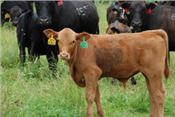Fall Calving Season May Yield Higher Returns For Southeastern Beef Producers
Risk And Returns Evaluated
KNOXVILLE, TENN.
The vast majority of cow-calf producers in Tennessee and the Southeast using a defined calving season have long favored spring calving; however, researchers at the University of Tennessee Institute of Agriculture have evaluated the risk and returns for a fall calving season, proving once again that timing is everything.
Selecting an optimal calving season involves a complex set of factors including nutritional demands of brood cows, forage availability, calf weaning weights, calving rates, seasonality in cattle, feed prices and labor availability.
Until now, information regarding profitability and risk associated with spring and fall calving seasons in the southeastern United States has been limited. Addressing this limitation, researchers assessed the potential trade-offs in risk and return of using a fall calving season rather than a spring calving season, while considering the seasonality of cattle and feed prices for least-cost feed rations.
Using simulation models based on 19 years of data, UTIA researchers determined that the fall calving season, calving between mid-September and mid-November, was most profitable and had the smallest amount of variation in profits, meaning fall calving was less risky.
This may seem counterintuitive, as spring calving produces heavier calves at weaning and feed costs are lower. The increased profitability of fall-season calving is due to the higher prices the calves can bring at weaning and an increase in calves weaned per cow.
Information from this research can help cow-calf producers in Tennessee and other southeastern states as they navigate the complex decision of choosing a calving season. Additional information can be found in the associated Extension publication Fall Versus Spring Calving: Considerations and Profitability Comparison.
“While this research indicates possible advantages for fall calving, it is also important to consider the additional costs associated with switching seasons and labor availability in the fall when crops are harvested,” says Chris Boyer, assistant professor for UT’s Agricultural and Resource Economics.
County Extension agents are available to help producers evaluate if fall calving is beneficial for their herds.
Fall Versus Spring Calving: Considerations and Profitability Comparison is available at no charge online at the UT Extension publications website: extension.tennessee.edu/publications. Simply search for the publication by title. ∆

While cow-calf producers in Tennessee and the Southeast have long favored
a spring calving season, new research from the University of Tennessee Institute
of Agriculture indicates possible advantages of a fall calving season.
Photo by T. Johnson, courtesy UTIA.